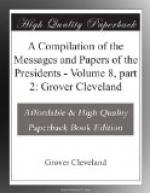In perfect accordance with this disposition to encroach is a proposition of the British minister (Mr. Vaughan) that inasmuch as the highlands can not be found by a due north direction from the monument we should vary west until we should intersect them, but not EAST. Now that in case a monument can not be found in the course prescribed you should look for it at the left, but not to the right, seems to us a very sinister proposition. We have shown, and, as we think, conclusively, that the range of highlands is to be looked for on British ground, and nowhere else, because it is their own boundary, and a line which must, with an ascertained north line, form the angle of one of their own Provinces. And yet we are not to examine there at all; we have never explored the country there, and are expected to yield to such arrogant, extravagant, and baseless pretensions!
We would ask why, in what justice, if we can not find the object in the route prescribed, are we to be thus trammeled? Where is the reciprocity of such a proposition, so degrading to the dignity and insulting to the rights and liberties of this State? No; the people of Maine will not now, and we trust they never will, tamely submit to such a one-sided measure.
The next restriction or limitation with which this negotiation is to be clogged is an admission that the Restigouche and St. John are not Atlantic rivers, because one flows into the Bay de Chaleurs and the other into the Bay of Fundy; yet neither falls into the river St. Lawrence. They would then find those highlands between the St. John and the Penobscot. There can not be a more arrogant pretension or palpable absurdity. Suppose the waters of both these rivers are excluded as flowing neither way, still the waters that flow each way are so far separated as to leave a tract of country which, if equally divided, would carry us far beyond the St. John. But we admit no such hypothesis. The Atlantic and the sea are used in the charters as synonymous terms. The Restigouche, uniting with the Bay de Chaleurs, which communicates with the sea, and the St. John, uniting with the Bay of Fundy, which also communicates with the sea, and that, too, by a mouth 90 miles wide, are both Atlantic rivers. These rivers were known by the negotiators not to be St. Lawrence rivers; they were known to exist, for they were rivers of the first class. If they were neither St. Lawrence nor Atlantic, why were they not excepted? They were not of the former, therefore they must be included in the latter description. Indeed, if rivers uniting with Atlantic bays are not Atlantic rivers, the Penobscot and Kennebec, which unite with the respective bays of Penobscot and Sagadahock, would not be Atlantic rivers, and then where are those highlands which divide the waters referred to in the treaty of 1783? Should we leave this question unsettled a little longer, and the British claims continue to increase, we might very soon find these highlands south of the Connecticut, and all the intermediate country would be recolonized by “construction.” We therefore invoke the sympathy of all New England, with New York besides, to unite against this progressive claim—this avalanche which threatens to overwhelm them as well as ourselves.




